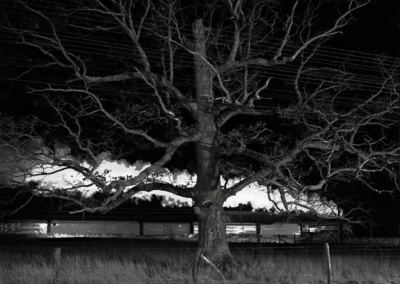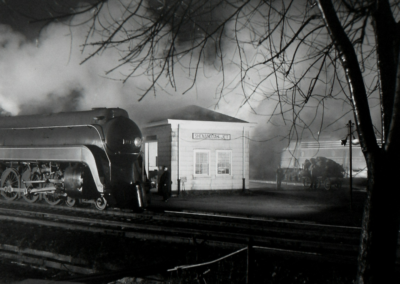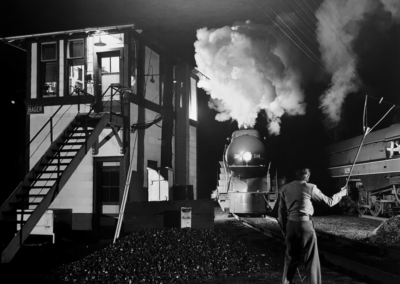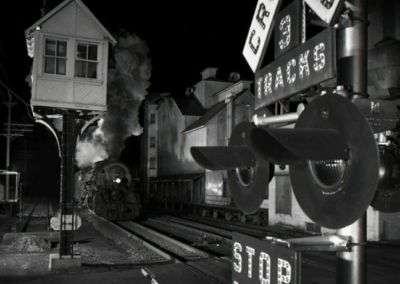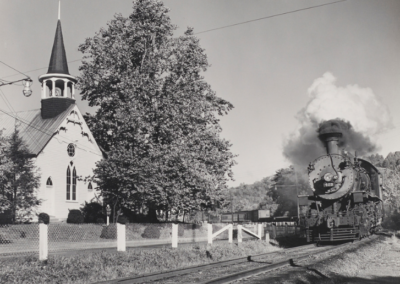Our next Artist You Need To Know is O. Winston Link (1914 – 2001).
Ogle Winston Link was an American photographer (though he was trained and worked as a civil engineer) whose many black and white photographs and sound recordings of the ‘last days of steam locomotives’ – specifically on the Norfolk & Western lines in the United States and the small towns they ran through in the late 1950s – have become iconic moments of social and industrial history, capturing a vanished time in the history of the United States.
He created an “elegiac portrait of the end of an era. By photographing the trains as seen through a living room window, from the edge of a public pool, or over the tops of cars parked at a drive-in, Link effectively showed how closely interwoven these technological relics were with the landscapes and lives through which they passed. Winston helped establish the ubiquity of rail photography and pioneered the use of night photography significantly.” (from here)
He once archly observed that “the locomotives are black. The coal is black. The tracks are black. The night is black. So what am I going to do with color?”
Link was born and grew up in Brooklynn, New York : his early photographic work employed a borrowed medium format Autographic Kodak camera but by the time he was in high school he had built his own photographic enlarger. Link attended the Polytechnic Institute of Brooklyn, receiving a degree in civil engineering. He also worked for the advertising firm Carl Byoir and Associates for five years, honing his skills as a photographer and travelling with his camera which helped shape his later interests and subject matter.
In the early 1940s with the United States entering WW II, Link was unable to enlist due to mumps-induced hearing loss, but he left his job with Byoir in 1942 to work for the Airborne Instruments Laboratory, part of Columbia University. His primary role was in photographing the project – but also working as a project engineer – which was focused upon creating a device to enable aircraft to detect submerged submarines. When the war ended in 1945, Byoir offered Link back his former job, but he chose to open his own studio in New York City instead, and had no trouble finding significant corporate clients.
This freelance work led him to his best known images of trains and the communities of which they were essential components. “While in Staunton, Virginia, for an industrial photography job in 1955, Link’s longstanding love of railroads became focused on the nearby Norfolk and Western Railway line. N&W was the last major (Class I) railroad to make the transition from steam to diesel motive power and had refined its use of steam locomotives, earning a reputation for “precision transportation.” Link took his first night photograph of the road on January 21, 1955, in Waynesboro, Virginia. He returned to Virginia for approximately 20 visits to continue photographing the N&W. His last night shot was taken in 1959 and the last of all in 1960. That year the road completed the transition to diesel, by which time he had accumulated 2400 negatives on the project.”
It’s important to note that while Link’s images are centered on the trains, many position the locomotives amidst scenes and people whose communities these trains served, defined and existed within, as part of a larger narrative about the lives of the people and, perhaps, the ‘lives’ of the trains as well.
Link’s once wryly commented when asked about taking his images almost exclusively at night that “I can’t move the sun — and it’s always in the wrong place — and I can’t even move the tracks, so I had to create my own environment through lighting.” He employed elaborate and technically innovate preparations for his shots, and he developed new methods employing flash photography to capture his scenes.
Link also made audio recordings of the trains, which he issued on a set of six gramophone records between 1957 and 1977 under the overall title Sounds of Steam Railroading. Many of these can be found on YouTube, including The Fading Giant.
From 1960 until he retired over two decades later, Link returned to working in advertising and industrial photography. Several of his more well known images include his photographs of the Verrazano – Narrows Bridge in New York City and other views of New York Harbor, often with images of the great ocean liners.
A traveling exhibition in 1983 brought his work to a wider public as did Paul Yule’s award-winning documentary Trains That Passed In The Night (1990), in which Link re-visited the scenes of his classic photographs of the Norfolk and Western. You can watch that here. There is another documentary – Dreams in Steam – which was produced for the O. Winston Link Museum by Steve Stinson with the participation of photographer Stephanie Klein Davis. This explores the process and technical innovations found within Link’s work.
O. Winston Link had a fatal heart attack and died in 2021 : he had been very involved, at the time of his death, with the planning of a museum of his work.
A more complete archive of the photography of Winston Link is housed at the O. Winston Link Museum in Roanoke, Virginia, which opened in January 2004. The museum is housed in the former passenger station of the Norfolk and Western Railway.





